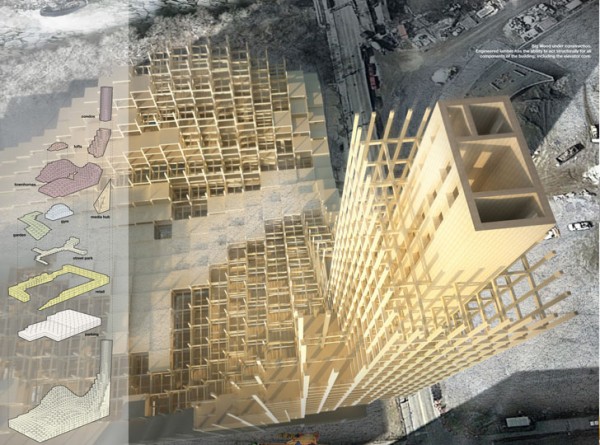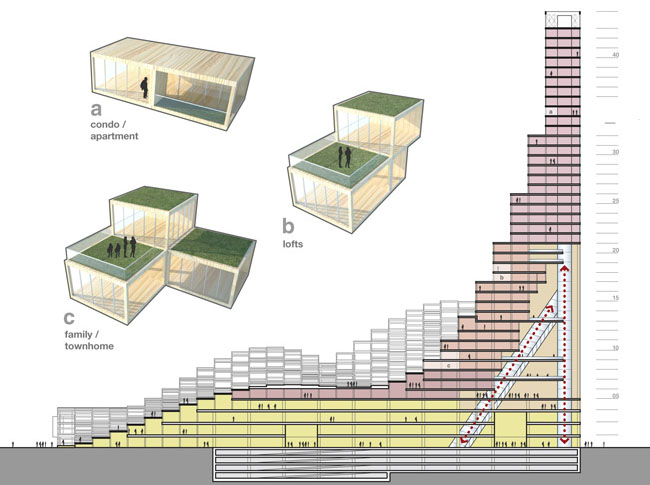At the 2013 eVolo Skyscraper Competition, a trippy entry called Big Wood made waves and earned an Honorable Mention. (Actually, this was among the tamest of the winning designs. Various others were designed for the North Pole, for the stratosphere, and for Mars.)
Back on Earth, within the same month an architect’s TED Talk called engineered wood the sustainable big-building material of the future.
Here’s architect Michael Charters’ drawing of Big Wood:

Intended for downtown Chicago (birthplace of the skyscraper) the building encompasses retail, a library, a school, a park, and many classes of condos.
The first objection most people raise to wooden skyscrapers is flammability. Big fires that ravaged US cities in the 1900s provoked building codes that prohibited wooden structures taller than four stories. That soon led to the development of skyscrapers, all made of steel, concrete, and glass. Tragically, on 9/11/2001 we all saw that steel in skyscrapers is not quite fireproof. It can melt.
Charters is explicitly following a path laid out by architect Michael Green of Vancouver, BC, who gave the TED talk. In his white paper, Tall Wood, Green offers many tests to back up his claim that his highly compressed engineered wood materials only char on the surface in a hot fire. That beats melting; structural members could still be strong enough to hold up a building after losing a little thickness to charring.
He makes a strong case on flammability, and also that modern wood products are strong enough to do the job, and also that wood in our built environment makes us happy. It’s natural, and indeed, wood is what nature came up with for organisms to grow really tall.

What about his central claim—that wood is more sustainable than steel and concrete? That construction with wood is even carbon-negative? That demands extremely complex calculations from which I don’t think we’ll see conclusive answers anytime soon.
Forest scientists at Oregon State University, for example, have published numerous studies concluding that all currently known forms of commercial tree removal have worse carbon footprints than leaving the forests alone. However, those studies rest on assumptions such as an 80-year lifespan, typical of American buildings. Different assumptions—based on what can and must be done, rather than on business as usual in the profligate past century—will give very different results. Green points to Japanese pagodas 19 stories high that are still standing after 1400 years.
I’m sure we’ll be hearing more on this front. At present, Green’s argument seems based less on data than on principle: Conventional construction has an egregious carbon footprint. Trees are the biggest and best terrestrial carbon sink. Sustainable timber production is possible. If we skim off a sustainable X amount of wood from our forests, while keeping them growing healthily, and if portion Y of what we harvest is put into buildings that will last hundreds of years and then be replaced with equal amounts of wood in other buildings, then we’ve enhanced the natural carbon sink by exactly Y. That’s net negative carbon.
I don’t know for sure; but it sounds well worth investigating.